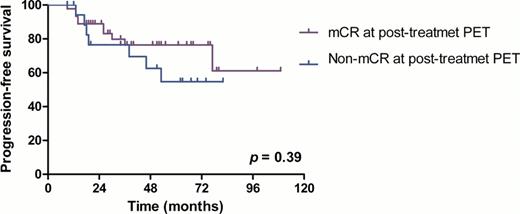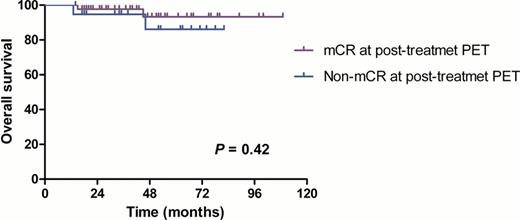Abstract
Abstract 5084
18F-fluorodeoxyglucose (FDG) positron emission tomography-computed tomography (PET-CT) scan has been increasingly used for initial staging and response evaluation in patients with lymphomas, and its clinical utility is well established in diffuse large B-cell lymphoma as well as Hodgkin lymphoma. However, its role remains undetermined in marginal zone lymphomas (MZL), most common type of indolent lymphoma in Korea, due to its relatively low FDG avidity. Thus, we aimed to assess the prognostic significance of PET-CT scan in patients with MZL.
We retrospectively reviewed the medical records of a total of 194 patients with pathologically confirmed MZL in the Asan Medical Center between February 2003 and February 2011. Post-treatment FDG PET-CT scan was defined as which performed during the periods of 2 to 4 weeks after the completion of induction chemotherapy or 7 to 9 weeks after radiotherapy. [a4] Among them, both baseline and post-treatment FDG PET-CT scans were performed in 64 patients. We investigated the prognostic significance of maximum standardized uptake value (SUVmax) at baseline PET-CT and metabolic complete response. Metabolic compete response (mCR) was defined as no pathologic FDG uptake at any site in post-treatment PET-CT scan. The log-rank test was used to assess the correlation of progression-free survival (PFS) and overall survival (OS) with baseline SUVmax or the presence of mCR.
In a total of analyzable 64 patients, histopathologic subtypes of them were as follow: extranodal marginal zone lymphoma (ENMZL=38, 59. 4%) including mucosa-associated lymphoid tissue (MALT) (n=35, 54. 7%) and bronchus-associated lymphoid tissue (BALT) (n=3, 4. 7%) lymphoma, nodal MZL (n=25, 39. 0%), splenic MZL (n=1, 1. 6%). The median SUVmax in baseline PET-CT was 4. 9 (range, 1. 3 – 18. 8). There were no significant associations of baseline SUVmax (cutoff: 5) to mCR at post-treatment PET-CT scan or survival outcomes. Patients group with high SUVmax (SUVmax >5. 0) showed mCR rate of 72. 7 %, and patients low SUVmax (SUVmax ° Â 5) showed mCR rate of 67. 7%, respectively. (p=0. 786). With a median follow-up duration of 46 monthss (range, 13 to 109 months), 5-year OS and PFS rate were 91% and 71%, respectively. 5-year PFS rate (76% vs. 62%, p=0. 27) did not differ between complete metabolic responders and incomplete responders. However, complete metabolic responders showed higher 5 year OS rate compared with incomplete responders (93% vs. 86%, p=0. 43) although statistical significance was not secured.
In the study cohort, baseline SUVmax was not a significant predictor of mCR, PFS nor OS. However, the patients achieved mCR at the end of induction treatment seemed to have superior survival rates than incomplete responders, which warrants further investigation.
Survival outcomes by mCR at post-treatment PET-CT
(A) Progression-free survival
(B) Overall survival
Survival outcomes by mCR at post-treatment PET-CT
(A) Progression-free survival
(B) Overall survival
No relevant conflicts of interest to declare.
Author notes
Asterisk with author names denotes non-ASH members.



This feature is available to Subscribers Only
Sign In or Create an Account Close Modal